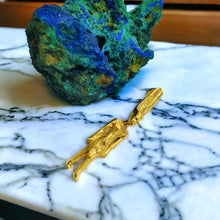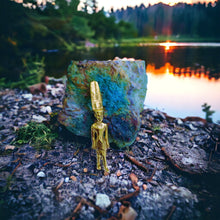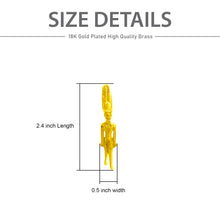
The God Amun Statue Gold Pendant Necklace embodies ancient Egyptian reverence, featuring a miniature rendition of the deity Amun, a symbol of divine power and kingship. Crafted with intricate detail, it pays homage to millennia-old traditions, merging history with modern elegance in wearable art.
- History: Inspired by ancient Egyptian deity, Amun, symbolizing mystery and power.
- Spiritually: Represents divine protection, strength, and wisdom.
- Talisman: Believed to bring luck, ward off negative energies, and enhance intuition.
- Handmade: Crafted with intricate detail and care, preserving ancient artisanal techniques.
- Healing: Thought to promote emotional balance and spiritual growth.
- Material Gold: Made of high-quality gold, symbolizing wealth, purity, and eternity.
- Symbolism: Amun symbolizes creation and hidden potential, reflecting the wearer's inner strength.
- How to Wear: Pendant fits any chain up to 5MM (0.2 inches), allowing versatile styling.
- Ideal Gift: Perfect for those seeking spiritual connection, protection, or admiration of ancient cultures.
History Side For Those Who Are Interested
Amun, one of the most significant and revered deities in ancient Egyptian mythology, had a profound impact on the religious and political landscape of Egypt throughout its long history. His origins can be traced back to the early periods of Egyptian civilization, with his worship evolving and expanding over millennia.
The earliest records of Amun date back to the Old Kingdom (c. 2686–2181 BCE), where he was often depicted as a local god of Thebes, known as "Amun-Re," combining attributes of both Amun and the sun god Re. However, it was during the Middle Kingdom (c. 2055–1650 BCE) that Amun's prominence began to grow, particularly as Thebes rose to power as the capital of Egypt's New Kingdom (c. 1550–1070 BCE).
During the New Kingdom, Amun became associated with the king's divine authority, symbolizing his role as the ruler and protector of Egypt. This association led to the development of the concept of the "living god," where the pharaoh was believed to be the earthly incarnation of Amun-Re. As a result, Amun's influence extended beyond religious spheres into the political realm, solidifying his status as one of the most powerful deities in the Egyptian pantheon.
Amun's importance continued to rise during the reign of the New Kingdom pharaohs, notably under rulers like Hatshepsut, Thutmose III, Amenhotep III, and Ramesses II. The wealth and power accumulated by the priesthood of Amun at the temple complex of Karnak in Thebes made the cult of Amun one of the wealthiest and most influential in Egypt. The vast resources controlled by the priesthood allowed them to exert considerable influence over Egyptian politics and society.
However, Amun's supremacy faced challenges during the reign of Akhenaten (c. 1353–1336 BCE), who attempted to elevate the status of the sun god Aten and diminish the influence of traditional gods like Amun. This period, known as the Amarna Period, saw significant religious and political upheaval as Akhenaten sought to establish Atenism as the state religion. However, after Akhenaten's death, his successors, notably Tutankhamun and the pharaohs of the subsequent dynasty, restored the worship of Amun and reinstated the priesthood's power.
Following the decline of the New Kingdom, Egypt entered a period of political fragmentation and foreign domination, culminating in the conquest of Egypt by Alexander the Great in 332 BCE. The Greek rulers of Egypt, known as the Ptolemies, adopted many aspects of Egyptian religion and continued to patronize the cult of Amun, albeit in a syncretic form with Greek deities.
The worship of Amun persisted into the Roman period, with the last temples dedicated to him remaining active until the rise of Christianity in Egypt in the early centuries CE. Despite the decline of traditional Egyptian religion, Amun's legacy endures through the countless temples, statues, and inscriptions dedicated to him, providing invaluable insights into the religious beliefs and practices of ancient Egypt.

















